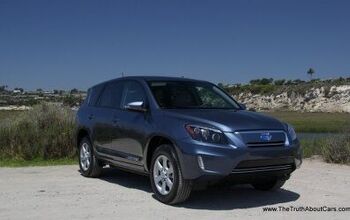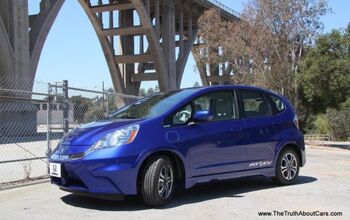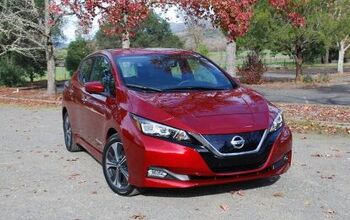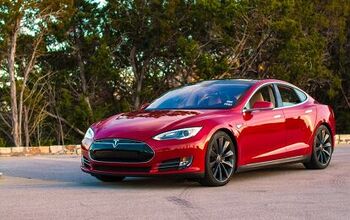Review: Revenge Of The Electric Car
Living in Northern California, electric cars are a common sight – all you have to do is look in the left lane. There are numerous Tesla Model S’s, Nissan Leafs, and the occasional Ford Focus or Chevrolet Spark EV. Plug-in hybrids like the Chevy Volt, Ford Fusion and C-MAX Energi, and the Prius hybrid can be seen every day. BMW is planning on releasing plug-in hybrids of its core models like the 3-Series and the X5 in 2016. Four years ago, that wasn’t the case.
Back in 2011, when the documentary Revenge of the Electric Car was released, Tesla was attempting to sell the last of their Roadsters and the Model S was still a prototype. The Volt and Leaf were about to go on sale in electric car-friendly states (like California). Gas was never below $3 a gallon that year. In 2015, there are at least 15 electric or plug-in hybrid vehicles with more on the way. Tesla is worth billions of dollars, even though it sells only one car, the Model S which in the documentary then-Jalopnik editor-in-chief Ray Wert refers to as “vaporware.” Today, gas is less than $2.50 in California.
In the Revenge of the Electric Car, director Chris Paine creates a follow-up documentary to 2006’s Who Killed the Electric Car?, which focused primarily on the mothballing of General Motors’ EV1 and investigating the reasoning behind automakers’ investing less money in electric vehicles. Paine wants to explore why large automakers like GM and Nissan are placing large bets on electric as well as find out what’s driving Tesla as well as an individual working out of a small warehouse to play in the electric vehicle market.
From 2007, the documentary follows three people who are leading the push into electric cars, Bob Lutz, Carlos Ghosn, Elon Musk, and Greg Abbott. Bob Lutz and Carlos Ghosn are portrayed as “The Man” at the world’s largest automakers, who are putting their jobs on the line in order to create electric car models. Elon Musk is illustrated as the visionary Silicon Valley CEO who is ‘disrupting’ the auto industry with his electric sports cars. Greg Abbott is the hippie who runs a cottage-industry business installing electric powertrains in classic cars, with an electrified Porsche 356 Speedster serving as a showcase of his skills.
The documentary emphasizes that building an electric vehicle is a difficult task that involves plenty of money and other resources. Bob Lutz discusses the effort he put in to get GM executives to green-light the Volt into production as GM lost plenty of money on the EV1 project. Ghosn extols the virtues of the Leaf’s affordability and mass-market appeal rather than discussing the possibilities of the project going sour. Musk expresses his views on how Tesla is the car company of the future. Abbott stresses that his electric cars are the best for the environment since he puts electric powertrains into existing cars. But none of these men know when they talk about these subjects about whether their bets would pay off.
Paine shows that not everything goes smoothly. In the case of Tesla, the documentary shows a warehouse full of Roadsters with defects that range from defective powertrains to dents on the cars’ bodies during shipping. There are meetings where Musk has to address Tesla’s cash flow problems. In GM’s case, the Volt needs to go for extra aerodynamic testing even though it debuted at GM’s 100th anniversary celebration. It also didn’t help that GM was being bailed out in 2008 and had to answer to Congress and government representatives. Abbott’s warehouse for his electric cars is burned down and his equipment is uninsured.
By 2011, when the documentary was released, Tesla had received its $400+ million loan from the Department of Energy. The Volt and Leaf were on sale and customers were just learning about their technology. Greg Abbott had finally found a place to rebuild his electric-vehicle conversion shop. Numerous other automakers such as BMW and Toyota were readying their electric vehicles. Gasoline prices weren’t seeming to go down anytime soon, and the federal and state incentives for electric vehicles were increasing. Meanwhile, America’s electrical grid was progressively turning to alternative sources of energy, making the operation of an electric vehicle cleaner. America largely knew the electric car was making a comeback.
It must be written that TTAC doesn’t come off well in Revenge of the Electric Car. During the time this documentary was being made, TTAC editor-in-chief Robert Farago was writing his “Tesla Death Watch” series of posts, screen caps of which appeared in the documentary while describing Tesla’s troubles. Though Tesla Motors was teetering on the brink when Robert Farago was writing his posts (and it took a loan from Daimler to keep Tesla afloat), the “Tesla Death Watch” comes off as shortsighted. When Paine films Musk’s reaction to Tesla’s initial public offering, Musk specifically references the “Tesla Death Watch” posts and says the people writing those posts will have to wait longer.
In my opinion, if there’s any individual who comes off as an electric car visionary, it’s Carlos Ghosn, not Elon Musk. From the start of the documentary, he seems very confident about the Leaf, allowing the film crew to shadow him to important meetings and discussions. In one conversation, he dismisses Mitsubishi’s i-MIEV, saying that it’s too expensive and won’t sell. At the 2009 Tokyo Motor Show, he evaluates other companies’ approach to electric vehicles and allows the press to hear his opinions on them. Even his answers to the press come off much better than those of Elon Musk in the documentary, when asked about the sales potential of the Leaf.
If you watch the documentary, most people who follow the automotive industry won’t be fazed by the content exhibited. Considering that GM did not go out of business, that Tesla did not fail, that the Leaf is on sale, and Greg Abbott still has his electric Speedster, and more than 20 electric and plug-in vehicles on the market, we know the electric car worked out fine. Left lanes across California during rush hour are full of them. But you should watch Revenge of the Electric Car (it’s on Netflix right now) as it illuminates the challenges endured by manufacturers to get electric vehicles onto the market. You’ll see firsthand the amount of stress, sweat, and anxiety that went into creating today’s electric vehicles.
Satish Kondapavulur is a writer for Clunkerture, where about a fifth of the articles are about old cars and where his one-time LeMons racing dreams came to an end, once he realized it was impossible to run a Ferrari Mondial. He still hasn’t driven a Nissan Leaf, despite his neighborhood being full of them.
More by Satish Kondapavulur
Latest Car Reviews
Read moreLatest Product Reviews
Read moreRecent Comments
- Kwik_Shift_Pro4X Thankfully I don't have to deal with GDI issues in my Frontier. These cleaners should do well for me if I win.
- Theflyersfan Serious answer time...Honda used to stand for excellence in auto engineering. Their first main claim to fame was the CVCC (we don't need a catalytic converter!) engine and it sent from there. Their suspensions, their VTEC engines, slick manual transmissions, even a stowing minivan seat, all theirs. But I think they've been coasting a bit lately. Yes, the Civic Type-R has a powerful small engine, but the Honda of old would have found a way to get more revs out of it and make it feel like an i-VTEC engine of old instead of any old turbo engine that can be found in a multitude of performance small cars. Their 1.5L turbo-4...well...have they ever figured out the oil dilution problems? Very un-Honda-like. Paint issues that still linger. Cheaper feeling interior trim. All things that fly in the face of what Honda once was. The only thing that they seem to have kept have been the sales staff that treat you with utter contempt for daring to walk into their inner sanctum and wanting a deal on something that isn't a bare-bones CR-V. So Honda, beat the rest of your Japanese and Korean rivals, and plug-in hybridize everything. If you want a relatively (in an engineering way) easy way to get ahead of the curve, raise the CAFE score, and have a major point to advertise, and be able to sell to those who can't plug in easily, sell them on something that will get, for example, 35% better mileage, plug in when you get a chance, and drives like a Honda. Bring back some of the engineering skills that Honda once stood for. And then start introducing a portfolio of EVs once people are more comfortable with the idea of plugging in. People seeing that they can easily use an EV for their daily errands with the gas engine never starting will eventually sell them on a future EV because that range anxiety will be lessened. The all EV leap is still a bridge too far, especially as recent sales numbers have shown. Baby steps. That's how you win people over.
- Theflyersfan If this saves (or delays) an expensive carbon brushing off of the valves down the road, I'll take a case. I understand that can be a very expensive bit of scheduled maintenance.
- Zipper69 A Mini should have 2 doors and 4 cylinders and tires the size of dinner plates.All else is puffery.
- Theflyersfan Just in time for the weekend!!! Usual suspects A: All EVs are evil golf carts, spewing nothing but virtue signaling about saving the earth, all the while hacking the limbs off of small kids in Africa, money losing pits of despair that no buyer would ever need and anyone that buys one is a raging moron with no brains and the automakers who make them want to go bankrupt.(Source: all of the comments on every EV article here posted over the years)Usual suspects B: All EVs are powered by unicorns and lollypops with no pollution, drive like dreams, all drivers don't mind stopping for hours on end, eating trays of fast food at every rest stop waiting for charges, save the world by using no gas and batteries are friendly to everyone, bugs included. Everyone should torch their ICE cars now and buy a Tesla or Bolt post haste.(Source: all of the comments on every EV article here posted over the years)Or those in the middle: Maybe one of these days, when the charging infrastructure is better, or there are more options that don't cost as much, one will be considered as part of a rational decision based on driving needs, purchasing costs environmental impact, total cost of ownership, and ease of charging.(Source: many on this site who don't jump on TTAC the split second an EV article appears and lives to trash everyone who is a fan of EVs.)


































Comments
Join the conversation
Wouldn't you be curious if GM had started the EV1 project let's say two years ago? It is such an interesting shape, simultaneously ultra-low drag as well as oozing "transportation of the near future". Actually, the EV1 was more ahead of its time than anything Tesla produces. In other words: the EV1 begs to start making an EV2. I wouldn't be surprised if GM could shave off substantial weight, as well as improving range. Perhaps something like this: https://localmotors.com/sevehicle/iphone-on-wheels-neither-car-nor-motorscooter/
Electric cars are in the left lane, and for that matter, in existence simply because governments at the state and federal level have given mandates that they be so. You get to drive your electric/hybrid solo in the HOV lanes (at sub optimal speeds)because "they" say you can. You can "afford" these vehicles because some government is giving lots of our tax money to car makers and buyers to "prove" there is a demand for them. This is the total extent of success for these cars.